ラテンアメリカの人びと
People of Latin America
Narrative of a five years' expedition against the revolted Negroes of Surinam, by Blake, William, 1757-1827 / América Invertida (1943)
ラテンアメリカの人びと
People of Latin America
Narrative of a five years' expedition against the revolted Negroes of Surinam, by Blake, William, 1757-1827 / América Invertida (1943)
池田光穂
★ラテンアメリカ人(スペイン語:ラテンアメリカ人、ポルトガル語:ラテ ンアメリカ人、フランス語:ラテンアメリカ人)とは、ラテンアメリカ諸国の国民(またはラテンアメリカに文化的、先祖的、あるいは民族的起源を持つ人々) を指す。 ラテンアメリカ諸国とそのディアスポラは多民族・多人種である。ラテンアメリカ人は、さまざまな民族・国家背景を持つ人々からなる汎民族である。そのた め、ラテンアメリカ人の中には、民族性として自国の国籍を認識せず、国籍、民族性、先祖の出身地を組み合わせたものとして自己を認識する者もいる。先住民 に加え、ラテンアメリカ人には1492年以降に到来した旧世界出身の祖先を持つ人々も含まれる。ラテンアメリカには、世界最大のスペイン人、ポルトガル 人、アフリカ人、イタリア人、レバノン人、そして日本人のディアスポラが存在する。[19][20][21] この地域には、ドイツ人(米国に次いで2番目に多い)[22]、フランス人、パレスチナ人(アラブ諸国以外では最大)[23]、中国人、ユダヤ人のディア スポラも存在する。 特定の民族および/または人種構成は国によって、またディアスポラのコミュニティによって異なる。多くの国では、先住民とヨーロッパ人の混血またはメスチ ゾが人口の大半を占めている。また、アメリカ先住民が多数派を占める国もある。ヨーロッパ系の人々が多く住んでいる地域もある。また、混血が大半を占める 地域もある。[18][24] 最大の単一グループは、白人ラテンアメリカ人である。[18] ヨーロッパ系の人々と併せると、人口のほぼ全体を占めることになる。[18] ラテンアメリカ人とその子孫は、世界のほぼあらゆる場所で見られ、特に人口密度の高い都市部に集中している。ラテンアメリカ人の主な移住先は、アメリカ合 衆国、スペイン、フランス、カナダ、イタリア、日本である。
★このページは関連ページである「ラテンアメリカという概念」より、スピンオフしました。
| Latin Americans
(Spanish: Latinoamericanos; Portuguese: Latino-americanos; French:
Latino-américains) are the citizens of Latin American countries (or
people with cultural, ancestral or national origins in Latin America). Latin American countries and their diasporas are multi-ethnic and multi-racial. Latin Americans are a pan-ethnicity consisting of people of different ethnic and national backgrounds. As a result, some Latin Americans do not take their nationality as an ethnicity, but identify themselves with a combination of their nationality, ethnicity and their ancestral origins.[18] In addition to the indigenous population, Latin Americans include people with Old World ancestors who arrived since 1492. Latin America has the largest diasporas of Spaniards, Portuguese, Africans, Italians, Lebanese and Japanese in the world.[19][20][21] The region also has large German (second largest after the United States),[22] French, Palestinian (largest outside the Arab states),[23] Chinese and Jewish diasporas. The specific ethnic and/or racial composition varies from country to country and diaspora community to diaspora community: many have a predominance of mixed indigenous and European descent or mestizo, population; in others, native Americans are a majority; some are mostly inhabited by people of European ancestry; others are primarily mulatto.[18][24] The largest single group are white Latin Americans.[18] Together with the people of part European ancestry, they combine for almost the totality of the population.[18] Latin Americans and their descendants can be found almost everywhere in the world, particularly in densely populated urban areas. The most important migratory destinations for Latin Americans are found in the United States, Spain, France, Canada, Italy and Japan. +++++++++++++++ Demographics Ethnic and Racial groups Main article: Race and ethnicity in Latin America 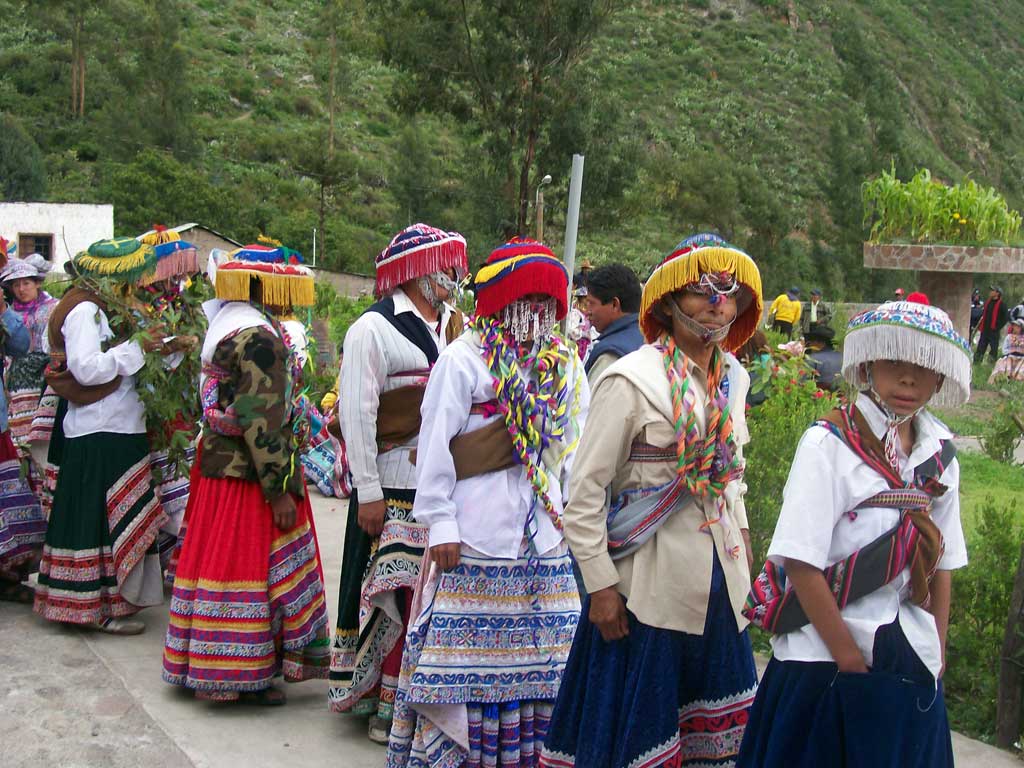 Wititi dancers from Colca Canyon, Peru. Indigenous people make up most of the population in Bolivia and Guatemala, and a quarter in Peru . 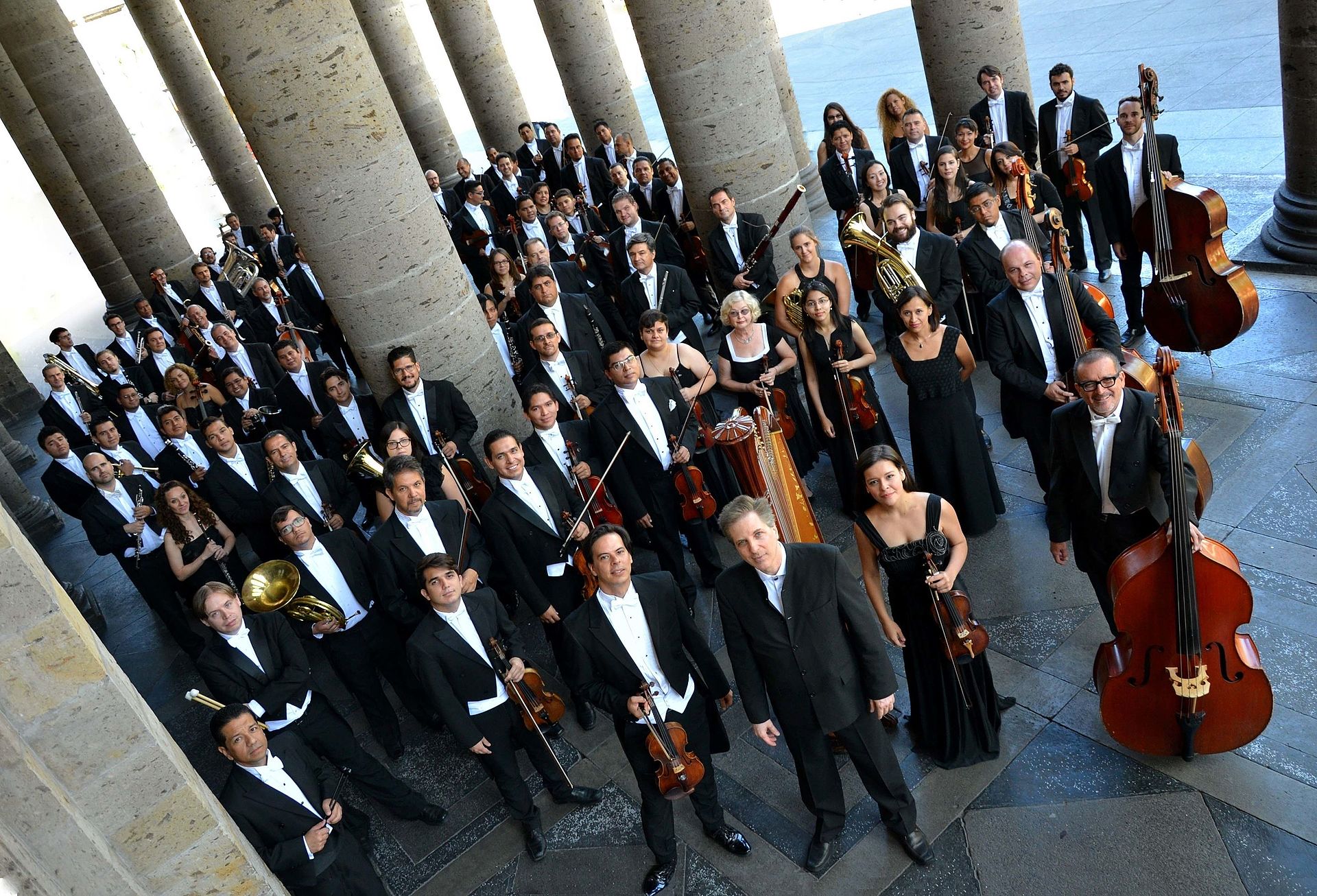 Mexican musicians from the Jalisco Philharmonic Orchestra. Mestizos comprise the majority of Mexicans 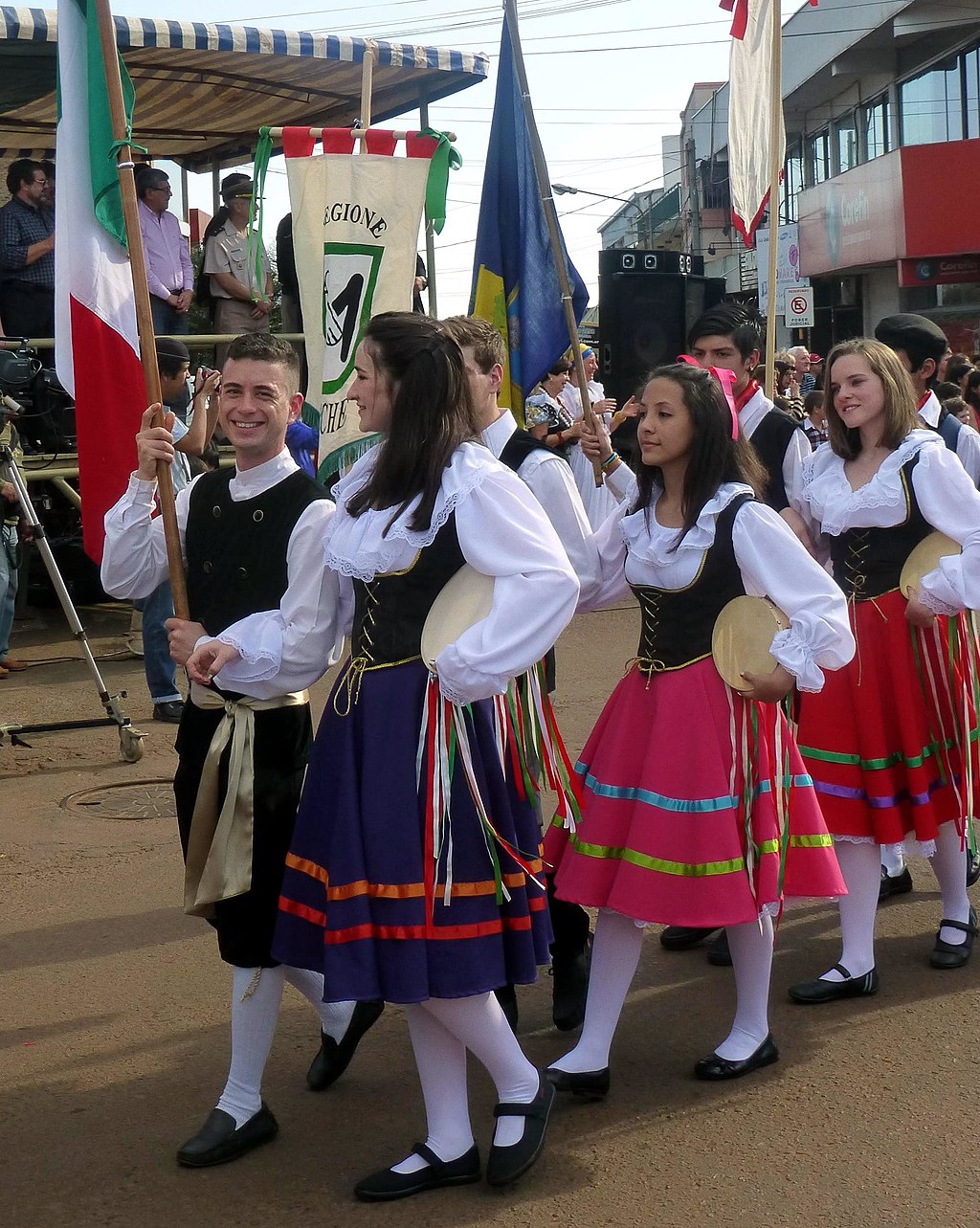 Italian Argentine youths in Oberá. Over 60% of Argentina's population has some degree of Italian ancestry.[28][29] 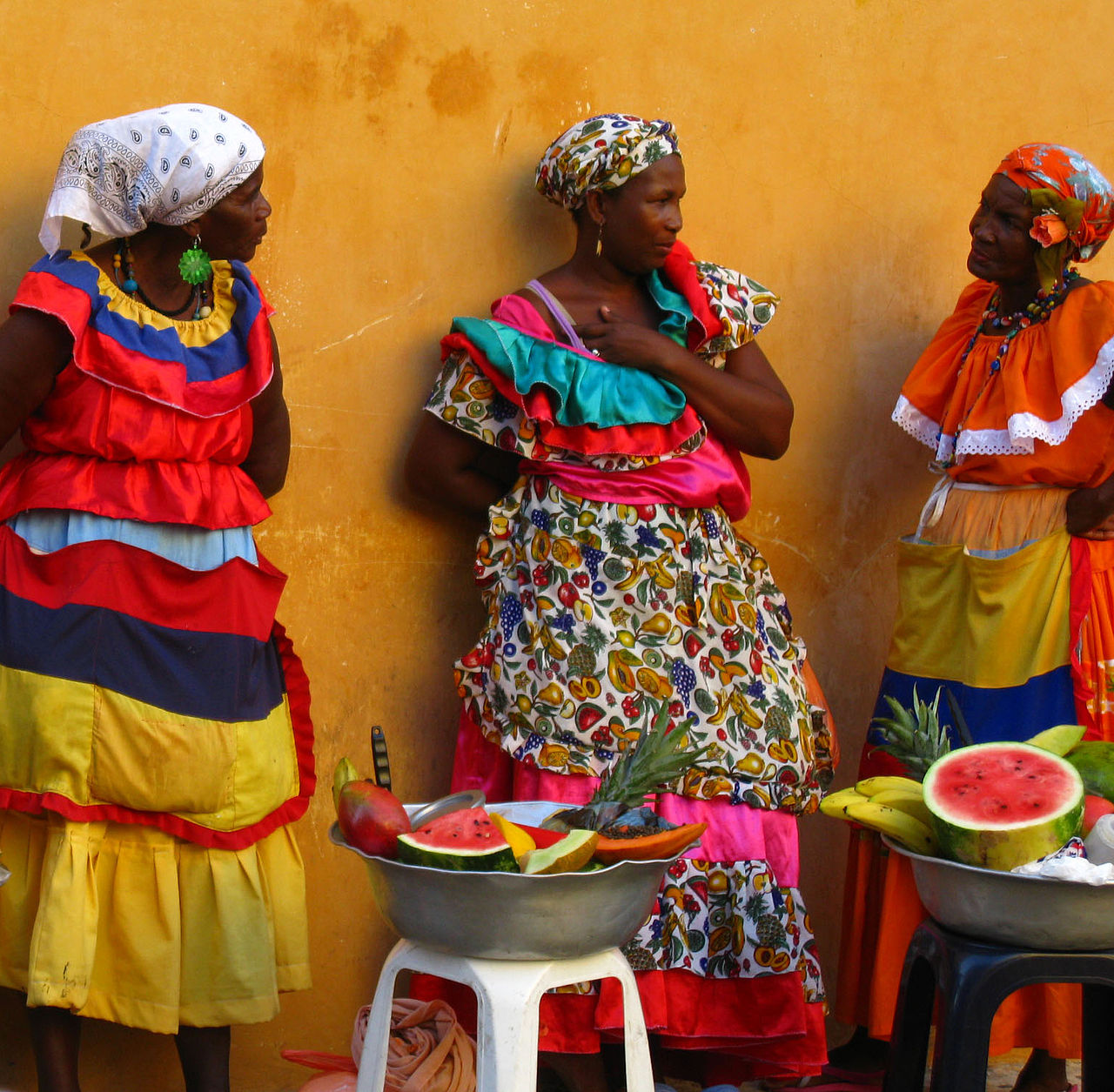 Afro-Colombian fruit sellers in Cartagena. 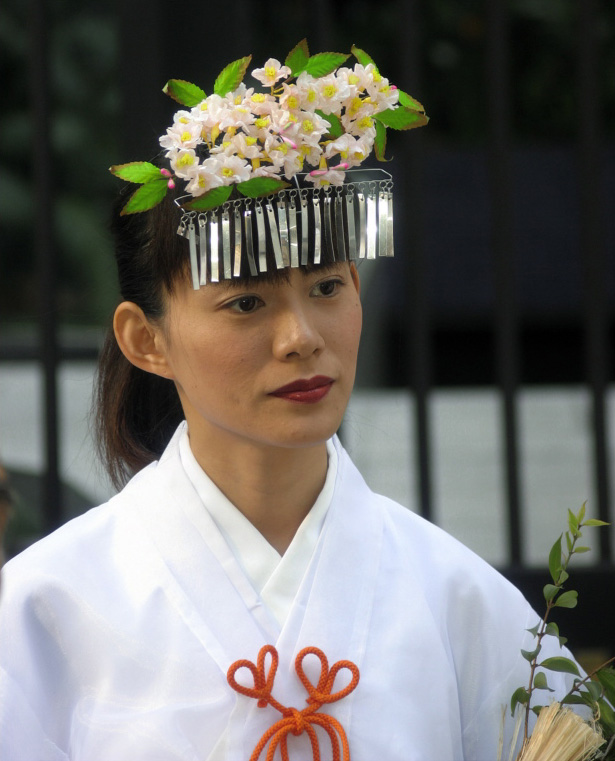 Woman from Curitiba, one of over a million Japanese Brazilians. 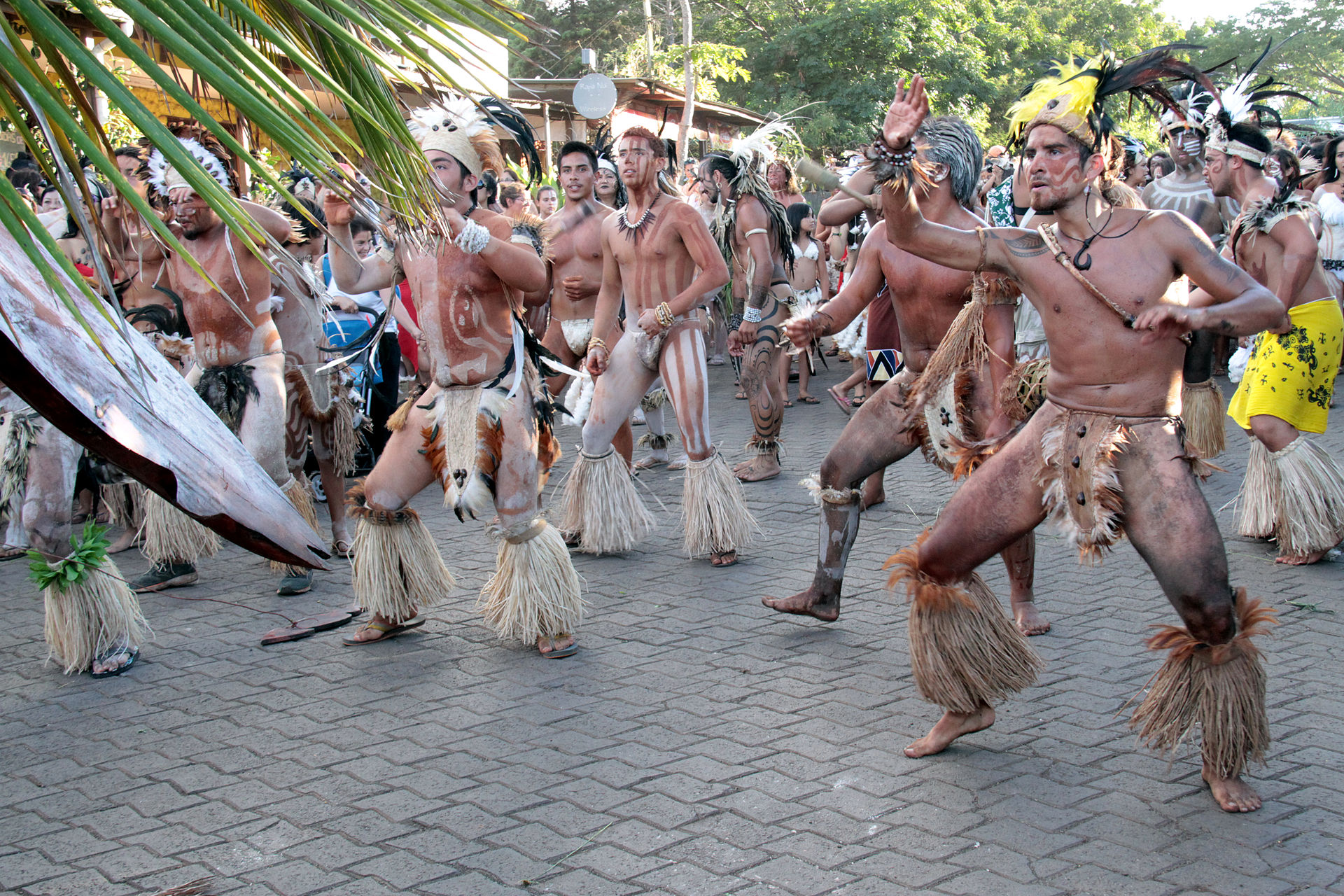 Rapa Nui dancers from Easter Island, Chile. The Rapa Nui are a Polynesian people. |
ラテンアメリカ人(スペイン語:ラテンアメリカ人、ポルトガル語:ラテ
ンアメリカ人、フランス語:ラテンアメリカ人)とは、ラテンアメリカ諸国の国民(またはラテンアメリカに文化的、先祖的、あるいは民族的起源を持つ人々)
を指す。 ラテンアメリカ諸国とそのディアスポラは多民族・多人種である。ラテンアメリカ人は、さまざまな民族・国家背景を持つ人々からなる汎民族である。そのた め、ラテンアメリカ人の中には、民族性として自国の国籍を認識せず、国籍、民族性、先祖の出身地を組み合わせたものとして自己を認識する者もいる。先住民 に加え、ラテンアメリカ人には1492年以降に到来した旧世界出身の祖先を持つ人々も含まれる。ラテンアメリカには、世界最大のスペイン人、ポルトガル 人、アフリカ人、イタリア人、レバノン人、そして日本人のディアスポラが存在する。[19][20][21] この地域には、ドイツ人(米国に次いで2番目に多い)[22]、フランス人、パレスチナ人(アラブ諸国以外では最大)[23]、中国人、ユダヤ人のディア スポラも存在する。 特定の民族および/または人種構成は国によって、またディアスポラのコミュニティによって異なる。多くの国では、先住民とヨーロッパ人の混血またはメスチ ゾが人口の大半を占めている。また、アメリカ先住民が多数派を占める国もある。ヨーロッパ系の人々が多く住んでいる地域もある。また、混血が大半を占める 地域もある。[18][24] 最大の単一グループは、白人ラテンアメリカ人である。[18] ヨーロッパ系の人々と併せると、人口のほぼ全体を占めることになる。[18] ラテンアメリカ人とその子孫は、世界のほぼあらゆる場所で見られ、特に人口密度の高い都市部に集中している。ラテンアメリカ人の主な移住先は、アメリカ合 衆国、スペイン、フランス、カナダ、イタリア、日本である。 ++++++++++++++++++++ 人口統計 民族および人種グループ 詳細は「ラテンアメリカにおける人種と民族(→人種概念をめぐるノート)」を参照  ペルーのクスコ渓谷のウィティティの踊り手。ボリビアとグアテマラでは先住民が人口の大半を占め、ペルーでは4分の1を占める。  メキシコのハリスコ・フィルハーモニー管弦楽団の音楽家。メキシコ人の大半は混血である  アルゼンチンのオベラに住むイタリア系アルゼンチン人の若者。アルゼンチンの人口の60%以上がイタリア系である。  カルタヘナのアフリカ系コロンビア人の果物売り。  100万人以上の日系ブラジル人の一人であるクリチバの女性。  チリのイースター島に住むラパ・ヌイ族のダンサー。ラパ・ヌイ族はポリネシア人である。 |
| The population of Latin America
comprises a variety of ancestries,
ethnic groups and races, making the region one of the most diverse in
the world. The specific composition varies from country to country:
many have a predominance of mixed European and native American, or
mestizo, population; in others, native Americans are a majority; some
are dominated by inhabitants of European ancestry; and some countries'
populations are primarily mulatto. Black, Asian, and zambo (mixed black
and native American) minorities are also identified regularly. White
Latin Americans are the largest single group, accounting for more than
one-third of the population.[18][30] |
ラテンアメリカは、さまざまな祖先を持つ人々、民族、人種から構成され
ており、世界で最も多様な地域のひとつとなっている。その構成は国によって異なり、
ヨーロッパ人とアメリカ先住民の混血、すなわちメスチゾが人口の大部分を占める国が多い。また、アメリカ先住民が多数派を占める国もある。ヨーロッパ系住
民が人口の大半を占める国や、混血が主となっている国もある。黒人、アジア人、そして黒人と先住民の混血であるサンボ(zambo)の少数民族も定期的に
確認されている。 白人のラテンアメリカ人は最大の単一グループであり、人口の3分の1以上を占めている。 |
| Asians. People of Asian descent
number several million in Latin America. The majority of Asian
descendants in the country are either of West Asian (such as Lebanese
or Syrian) or East Asian (like Chinese or Japanese) descent.[31] The
first Asians to settle in the region were Filipino, as a result of
Spain's trade involving Asia and the Americas. The Brazilian Institute
of Geography and Statistics states that the country's largest Asian
communities are from West Asia and East Asia.[32] It is estimated that
7 to 10 million Brazilians are of Lebanese descent.[33][34] Around 2
million Brazilians self-identify as being "Yellow" (amarela or of East
Asian descent) according to the 2010 census.[35] The country is home to
the largest ethnic Japanese community outside Japan itself, estimated
as high as 1.5 million, and circa 200,000 ethnic Chinese and 100,000
ethnic Koreans.[36][37] Ethnic Koreans also number tens of thousands of
individuals in Argentina and Mexico.[38] The 2017 census stated that
under 40,000 Peruvians self-identified as having Chinese or Japanese
ancestry.[39] Though other estimates claim as much as 1.47 million
people of East Asian descent reside in the country.[40][41] Lebanese
and Syrian descendants have also formed notable communities in
countries like Mexico and Argentina.[42] The Martiniquais population
includes a mixed African, European and native American descent, and an
East Indian (Asian Indian) population is also present in
Martinique.[43] In Guadeloupe, an estimated 14% of the population is of
East Asian descent. |
アジア系。ラテンアメリカにおけるアジア系住民は数百万に上る。ブラジ
ル国内のアジア系住民の大半は西アジア(レバノン人やシリア人など)または東アジア
(中国人や日本人など)の血を引いている。ブラジル地理統計院は、同国最大の東アジア系および西アジア系コミュニティはレバノン系であると述べている。
[32] 推定700万人から1,000万人のブラジル人がレバノン系であるとされている。[33][34]
2010年の国勢調査によると、約200万人のブラジル人が「黄色人種」(amarelaまたは東アジア系)であると自己申告している。[35]
同国には、日本国外では最大の日本人コミュニティがあり、
150万人と推定される最大の日本人コミュニティ、およそ20万人の中国人、10万人の韓国人が暮らしている。[36][37]
韓国人もアルゼンチンとメキシコに数万人いる。[38]
2017年の国勢調査では、4万人未満のペルー人が中国または日本の祖先であると自己申告していると述べている。[39] 他の推定では、
東アジア系の人々が147万人も居住しているという推計もあるが[40][41]、レバノン人とシリア人の子孫もメキシコやアルゼンチンなどの国々で顕著
なコミュニティを形成している[42]。マルティニーク島には、アフリカ、ヨーロッパ、先住民のアメリカ人の混血の人々や、東インド人(アジア系インド
人)も居住している[43]。グアドループ島では、人口の14%が東アジア系である。 |
| Blacks. Millions of African
slaves were brought to Latin America from the 16th century onward, most
of whom were sent to the Caribbean region and Brazil. Today, people
identified as "black" are most numerous in Brazil (more than 10
million) and in Haiti (more than 7 million).[44] Significant
populations are also found in Cuba, Dominican Republic, Puerto Rico,
Panama and Colombia. Latin Americans of mixed black and white ancestry,
called mulattoes, are far more numerous than blacks. Native Americans. The indigenous population of Latin America arrived during the Lithic stage. In post-Columbian times, they experienced tremendous population decline, particularly in the early decades of colonization. They have since recovered in numbers, surpassing sixty million (by some estimates[30]), though, with the growth of the other groups, they now comprise a majority only in Bolivia. In Guatemala, native Americans are a large minority that comprises 41% of the population.[45] Mexico's 21% (9.8% in the official 2005 census) is the next largest ratio, and one of the largest indigenous population in the Americas in absolute numbers. Most of the remaining countries have native American minorities, in every case making up less than one-tenth of the respective country's population. In many countries, people of mixed indigenous and European ancestry, known as mestizos, make up the majority of the population. |
黒人。16世紀以降、数百万人のアフリカ人奴隷がラテンアメリカに連れ
てこられ、そのほとんどがカリブ海地域とブラジルに送られた。今日、「黒人」とされ
る人々はブラジル(1,000万人以上)とハイチ(700万人以上)に最も多く存在している。[44]
また、キューバ、ドミニカ共和国、プエルトリコ、パナマ、コロンビアにもかなりの人口が存在している。黒人と白人の混血であるラテンアメリカ人は、ムラー
トと呼ばれ、黒人よりもはるかに多い。 ネイティブアメリカン。ラテンアメリカの土着民族は、石器時代に到来した。コロンブス以降の時代には、特に植民地化の初期の数十年間に、人口が大幅に減少 した。その後、人口は回復し、6,000万人を超えた(推定値による[30])が、他のグループの増加に伴い、現在はボリビアのみで多数派を占めている。 グアテマラでは、先住民は人口の41%を占める大きな少数派である。[45] メキシコの21%(2005年の公式国勢調査では9.8%)は、次に大きな割合であり、絶対数ではアメリカ大陸で最大の先住民人口のひとつである。 残りのほとんどの国々では、先住民は少数派であり、いずれもそれぞれの国の人口の10分の1以下である。多くの国々では、先住民とヨーロッパ人の混血であ るメスチーソと呼ばれる人々が人口の多数を占めている。 |
| Mestizos. Intermixing between
Europeans and native Americans began early in the colonial period and
was extensive. The resulting people, known as mestizos, make up the
majority of the population in half of the countries of Latin America.
Additionally, mestizos comprise large minorities in nearly all the
other mainland countries. |
メスティーソ。ヨーロッパ人と先住民の混血は、植民地時代初期から始ま
り、広範囲にわたって行われた。その結果生まれたメスチーソと呼ばれる人々は、ラテン
アメリカ諸国の半数で人口の多数を占めている。さらに、メスチーソは、他のほとんどの本土諸国でも大きな少数派を構成している。 |
| Mulattoes. Mulattoes are people
of mixed European and African ancestry, mostly descended from Spanish,
French, or Portuguese settlers on one side and African slaves on the
other, during the colonial period. Brazil is home to Latin America's
largest mulatto population. Mulattoes form a majority in the Dominican
Republic and are also numerous in Cuba, Puerto Rico, Nicaragua, Panama,
Peru, Colombia, and Ecuador. Smaller populations of mulattoes are found
in other Latin American countries.[30] |
ムラート。ムラートはヨーロッパ人とアフリカ人の混血であり、そのほと んどが植民地時代にスペイン人、フランス人、ポルトガル人の入植者の一方とアフリカ 人奴隷の一方の血筋を受け継いでいる。ブラジルはラテンアメリカ最大のムラート人口を抱える国である。ムラートはドミニカ共和国では多数派であり、キュー バ、プエルトリコ、ニカラグア、パナマ、ペルー、コロンビア、エクアドルでも多数を占めている。ラテンアメリカ諸国には、より少数の混血が存在する。 [30] |
| Whites. Beginning in the late
15th century, large numbers[18] of Iberian colonists settled in what
became Latin America (Portuguese in Brazil and Spaniards elsewhere in
the region), and at present most white Latin Americans are of Spanish,
Portuguese or Italian ancestry. Iberians brought the Spanish and
Portuguese languages, the Catholic faith, and many Iberian traditions.
Brazil, Argentina, Mexico and Venezuela contain the largest numbers of
Europeans in Latin America in pure numbers.[18] They make up the
majority of the population of Argentina, Costa Rica, Cuba and Uruguay
and roughly half of Brazil's and Venezuela's population.[18][46] Of the
millions of immigrants since most of Latin America gained independence
in the 1810s–1820s, Italians formed the largest group, and next were
Spaniards and Portuguese.[47] Many others arrived, such as French,
Germans, Greeks, Poles, Ukrainians, Russians, Croats, Serbs, Latvians,
Lithuanians, English, Jews, Irish and Welsh. Most Latin Americans have
some degree of European ancestry, when talking into account those of
either mixed or full European descent.[48] |
白人。15世紀後半から、イベリア半島からの多数の入植者(ブラジルで
はポルトガル人、その他の地域ではスペイン人)がラテンアメリカに移住し、現在で
は、ラテンアメリカ人の白人の大半はスペイン人、ポルトガル人、イタリア人の子孫である。イベリア人はスペイン語やポルトガル語、カトリック信仰、そして
多くのイベリアの伝統をもたらした。ブラジル、アルゼンチン、メキシコ、ベネズエラにはラテンアメリカで最も多くのヨーロッパ人が純粋な数で存在してい
る。[18]
彼らはアルゼンチン、コスタリカ、キューバ、ウルグアイの人口の大多数を占め、ブラジルとベネズエラの人口の約半数を占めている。[18][46]
1810年代から1820年代にかけてラテンアメリカ諸国のほとんどが独立を達成して以来、数百万人の移民のうち、イタリア人が最大のグループを形成し、
次いでスペイン人とポルトガル人が続いている。[47]
その他にも、フランス人、ドイツ人、ギリシャ人、ポーランド人、ウクライナ人、ロシア人、クロアチア人、
イタリア人が最も多く、次いでスペイン人、ポルトガル人が多い。[47]
その他にも、フランス人、ドイツ人、ギリシャ人、ポーランド人、ウクライナ人、ロシア人、クロアチア人、セルビア人、ラトビア人、リトアニア人、イギリス
人、ユダヤ人、アイルランド人、ウェールズ人などが多く移住している。ラテンアメリカ人のほとんどは、ヨーロッパ人の血を引く者、またはヨーロッパ人の血
を引く混血である。 |
| Zambos: Intermixing between
blacks and native Americans was especially prevalent in Colombia and
Brazil, often due to slaves running away (becoming cimarrones: maroons)
and being taken in by indigenous villagers. In Spanish-speaking
nations, people of this mixed ancestry are known as zambos,[49] and
they are also known as cafuzos in Brazil. |
ザンボス:黒人とアメリカ先住民の混血は、特にコロンビアとブラジルで
多く見られ、その原因は奴隷の逃亡(シマロン:マローン)や先住民の村に受け入れら
れたことによる場合が多い。スペイン語圏では、この混血の人々はザンボスと呼ばれ、ブラジルではカフゾスとも呼ばれる。 |
| Multi-ethnic/Multi-racials: In
addition to the foregoing groups, Latin America also has millions of
peoples who belong to multiracial backgrounds.[citation needed] |
多民族・多人種:前述のグループに加え、ラテンアメリカには多民族背景
を持つ何百万人もの人々がいる。[要出典] |
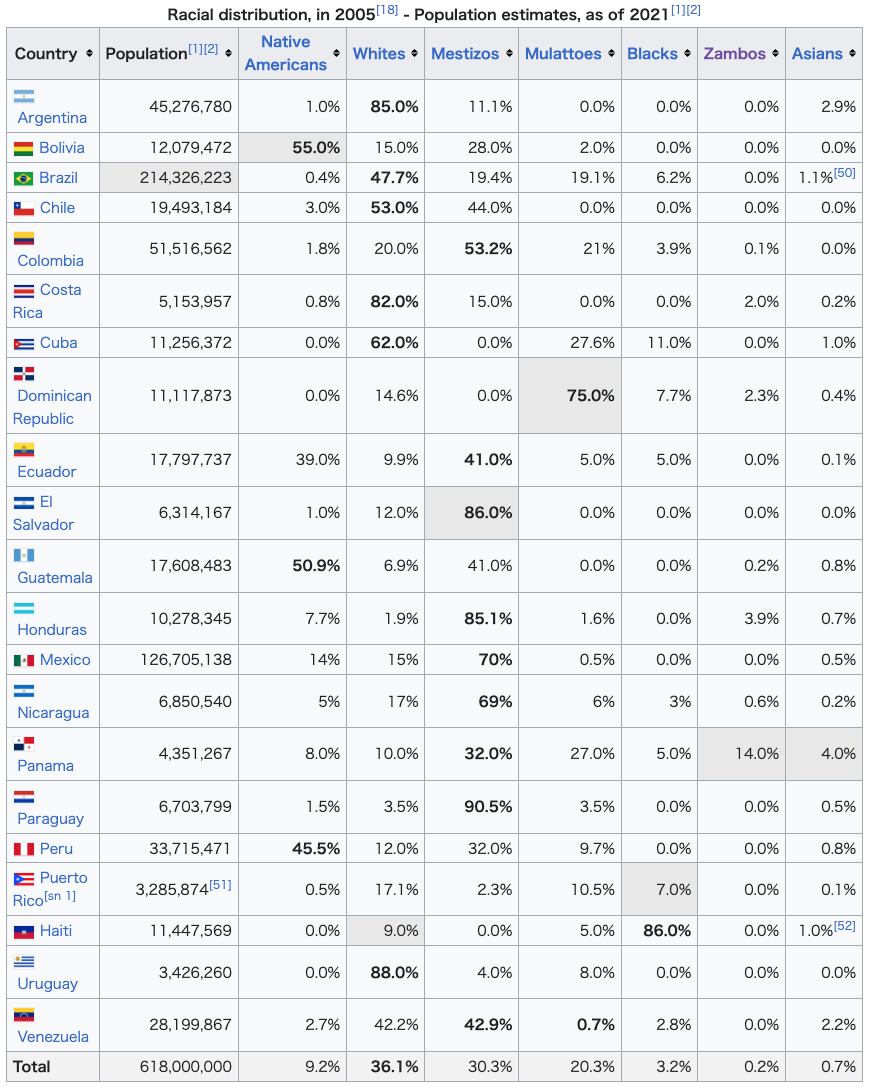 |
 |
| Racial groups according to
self-identification The Latinobarómetro surveys have asked respondents in 18 Latin American countries what race they considered themselves to belong to. The figures shown below are averages for 2007 through 2011.[53] 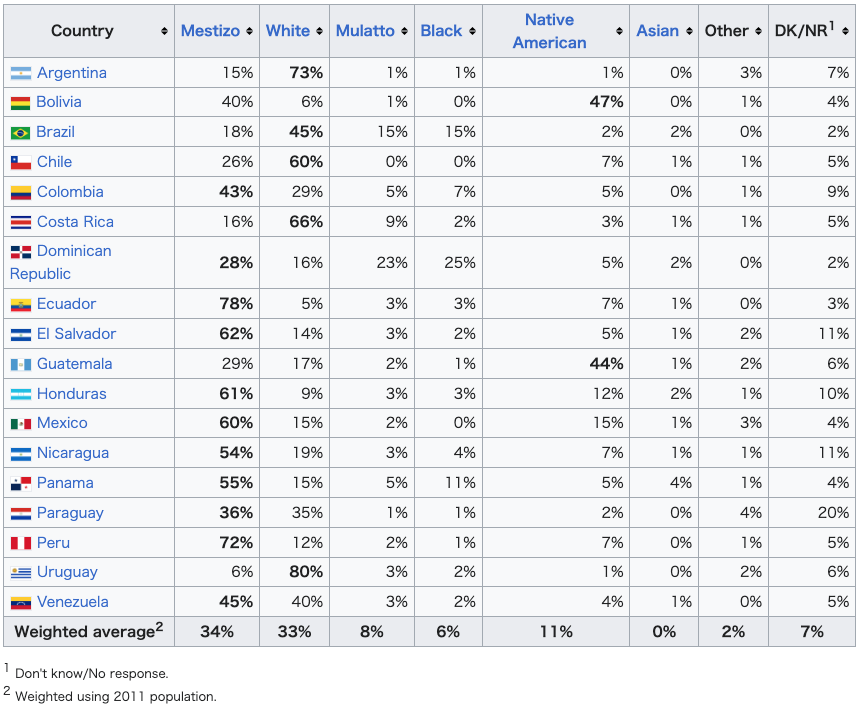 |
自己認識による人種グループ ラテン・オロメーターの調査では、18カ国のラテンアメリカ諸国に住む回答者に、自分自身がどの人種に属すると考えているかを尋ねている。以下に示す数値 は、2007年から2011年までの平均値である。[53]  |
| https://en.wikipedia.org/wiki/Latin_Americans |
*****
文献
Copyleft,
CC, Mitzub'ixi Quq Chi'j, 1996-2099
☆
 ☆
☆